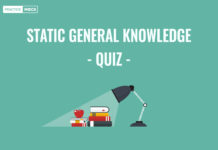Indian Freedom Struggle -General Knowledge Questions and Answers
The Revolt of 1857
This mutiny began with a revolt by the soldiers at Meerut who were unemployed. The cause of their unemployment was the new cartridge introduced in the new Enfield Rifles which contained grease made of cow and pig fat which had to be removed by their mouths inorder to use the weapon. This was not religiously agreeable and accepted to both the Hindu and the Muslim soldiers, hence, they refused to use the weapon and in return they were left unemployed.
Soon this revolt became widespread, mainly in Delhi and the nearby states. But this revolt proved to be a failure and the British army shot back by plundering, loots, murders etc. and left the people helpless. This revolt affected Delhi, Awadh, Rohilkhand, Bundelkhand,Allahabad, Agra, Meerut and western Bihar the most where some of the most ferocious battles were fought. But still the revolt of 1857 did not prove to be a success and failed within a year.
Indian National Congress (INC) came into existence
The foundation of the INC was laid in 1885. Its main aim was to put forward the view of the middle class educated citizens. In 1906,the Congress session at Calcutta gave a call to the attainment of ‘Swaraj’ and hence the ‘Swadeshi Movement’ started.
In 1905, the partition of West Bengal took place and the capital of the country was shifted from Calcutta to Delhi.
Simultaneously, the British government too was preparing against the Indian efforts and as a result they passed several reforms in1909 known as the Morley-Minto reforms which instead of the development aimed at creating differences between the Hindus and the Muslims.
On one hand, the reformists and the revolutionaries were working and planning whereas on the other hand, the Jallianwala massacre took place in Punjab in 1919 where people had gathered to celebrate Baisakhi.
It was after the First World War (1914-1918) that Mahatma Gandhi came back to India and observed the condition of the country and started the non-violent agitation, “Satyagrah”.
Non-Cooperation Movement
In 1920, Mahatma Gandhi started the Non-Cooperation Movement after realising that it was baseless to expect a fair treatment from the British government. This movement continued till 1922 and proved tobe a great success.
Simon Commission
Immediately after the non-cooperation movement was called off, in1927, another commission was introduced in the Indian government which had no Indian member included in the reforms and showed no intention of accepting the demand for ‘Swaraj’. Under the leadership of Lala Lajpat Rai, great protests were held.
Civil Disobedience Movement
The Civil Disobedience Movement started in December 1929 and it aimed at complete ignorance and disobedience of the British government. It was during this movement that the revolutionaries:Bhagat Singh, Sukhdev and Rajguru were arrested and hanged to death.
Quit India Movement
It was in August 1942 that Gandhiji started this movement which aimed at complete freedom from the British rule and posed as a ‘do or die’ situation. There were widespread actions of sabotage, violent protests etc. Finally Netaji Subhash Chandra Bose fled from the British detention and formed the Indian National Army. India got its freedom in August 1947 from the ruthless British rule after all the hard work, sacrifice and selflessness of the rulers, revolutionaries and citizens of the then country.
Important Years and Events
| Year | Location | Event |
| 1857 | Meerut | Sepoy Mutiny |
| 1858 | Calcutta | East India Company abolished |
| 1858 | Gwalior | Battle of Gwalior when Rani Lakshmi Bai with Maratha rebelscaptured Gwalior from Scindia rulers |
| 1858 | Jhansi | Rani Laxmi Bai died |
| 1859 | Shivpuri | Tatya Tope captured and executed |
| 1876 | Queen Victoria declared as the “Empress of India” | |
| 1885 | Bombay | Indian National Congress (INC) formed by AO Hume |
| 1898 | Lord Curzon became Viceroy | |
| 1905 | Surat | Swadeshi Movement started |
| 1905 | Bengal | Partition of Bengal |
| 1906 | Dhaka | All India Muslim League founded |
| 1908 | Mandalay | Tilak was sentenced to six years on charges of sedition |
| 1909 | Minto-Morley Reforms or Indian Councils Act | |
| 1911 | Delhi | Delhi durbar held. Partition of Bengal was cancelled |
| 1912 | Delhi | Delhi established as the new capital of India |
| 1912 | Delhi | Delhi Conspiracy Case to assassinate Lord Hardinge (Viceroy ofIndia) |
| 1914 | The Ghadar Party was formed at San Francisco | |
| 1915 | Mumbai | Gopal Krishna Gokhale died |
| 1916 | Pune | Tilak founded Indian Home Rule League first in Poona (Pune) |
| 1916 | Madras | Annie Besant led Home Rule League |
| 1917 | Champaran | Mahatma Gandhi launched the Champaran campaign in Bihar |
| 1918 | Champaran | Champaran Agraria Law passed |
| 1918 | Beginning of trade union movement in India | |
| 1919 | Amritsar | Jallianwala Bagh Massacre |
| 1919 | Rowlatt Act passed by Imperial Legislative Council in London | |
| 1919 | Khilafat Movement started | |
| 1920 | Non-Cooperation Movement started | |
| 1920 | All India Trade Union Congress started | |
| 1920 | Calcutta | Gandhiji proposed a resolution that called for British to grantdominion status to India |
| 1921 | Malabar | Moplah rebellion |
| 1922 | Chauri Chaura | Chauri Chaura incident |
| 1922 | Allahabad | Swaraj Party formed |
| 1925 | Communist Party of India was formed | |
| 1925 | Kakori | Kakori Conspiracy |
| 1925 | Bardoli | Bardoli Satyagraha |
| 1928 | Bombay | Simon Commission arrives in Bombay and an all-India hartal wasobserved |
| 1928 | Lahore | Lala Lajpat Rai assaulted by police at Lahore and later dieddueto injuries |
| 1928 | Nehru Report proposed new Dominion Constitution of India. | |
| 1929 | Lahore | Lahore Session of the Indian National Congress held |
| 1929 | Lahore | Freedom fighter Jatindra Nath Das fasted till death demandingfor better facilities for prisoners |
| 1929 | All Parties Muslim Conference formulates the ‘Fourteen Points’ | |
| 1929 | Delhi | Central Legislative Assembly bomb throwing incident |
| 1929 | Lord Irwin announced that the Government would meet for a RoundTable Conference with Indian representatives | |
| 1929 | Lahore | Jawaharlal Nehru hoisted the flag of India |
| 1930 | Purna Swaraj declaration was publicised by the IndianNationalCongress | |
| 1930 | Sabarmati Ashram | Beginning of Civil Disobedience Movement with Dandi March orthe Salt March |
| 1930 | Chittagong | Chittagong Armoury Raid |
| 1930 | London | First Round Table Conference begins in London to consider thereport of the Simon Commission |
| 1931 | Lahore | Bhagat Singh, Sukhdev and Rajguru hanged till death |
| 1931 | Gandhi Irwin Pact signed by Mahatma Gandhi and Lord Irwin | |
| 1931 | Second Round Table Conference | |
| 1932 | British Prime Minister, Ramsay Macdonald announced the”CommunalAward” to grant separate electorates to Indian minoritycommunities | |
| 1932 | Gandhiji began his “fast unto death” to improvestatus of untouchable castes that lasted for six days | |
| 1932 | London | The Third Round Table Conference |
| 1935 | The Government of India Act 1935 passed | |
| 1937 | Indian Provincial Elections held under the Government of IndiaAct 1935 | |
| 1938 | Haripura | Haripura session of the Indian National Congress held |
| 1938 | Subhash Chandra Bose was elected as the President of the IndianNational Congress | |
| 1939 | Congress ministries in the provinces resigned to protestagainst the war policy of the British government. Subhash ChandraBose resigned from the post of the Indian National Congress’President | |
| 1939 | The Muslim League observes ‘Deliverance Day’ to celebratetheresignation of the Congress ministries | |
| 1940 | Lahore Session held by the Muslim League for the creation of’Independent States’ for Muslims | |
| 1940 | ‘August Offer 1940′ made by Lord Linlithgow that offeredIndians’ the right to create their own Constitution | |
| 1940 | Wardha | Congress Working Committee rejects the ‘August Offer’ andlaunched ‘Individual Satyagraha’ |
| 1941 | Subhash Chandra Bose escapes from India | |
| 1942 | Quit India Movement or August Movement started | |
| 1942 | Churchill announces the Cripps Mission | |
| 1942 | Bombay | Indian National Congress adopted ‘Quit India’ Resolution |
| 1942 | ‘Azad Hind Fauj’ established | |
| 1943 | Karachi | Karachi session of the Muslim League adopted the slogan ‘Divideand Rule’ |
| 1944 | Moirang | Colonel Shaukat Malik of the Azad Hind Fauj defeated Britishinthe region with Japanese support |
| 1944 | Simla | Simla Conference held between Viceroy Archibald Wavellin andIndian political leaders |
| 1946 | Delhi | Cabinet Mission Plan passed |
| 1946 | Delhi | Constituent Assembly formed |
| 1946 | Delhi | Cabinet Mission arrives in New Delhi |
| 1946 | Lahore | Jawaharlal Nehru takes over as Congress President |
| 1946 | Interim Government of India formed | |
| 1946 | Delhi | First session of the Constituent Assembly of India held |
| 1947 | British Prime Minister, Clement Attlee declared that theBritish government would grant full self government to BritishIndia | |
| 1947 | Lord Mountbatten appointed as the Viceroy of India and thenbecame the first Governor General of Independent India | |
| 1947 | Mountbatten Plan was made for the partition of India into fullysovereign dominions – India and Pakistan with effect from15thAugust 1947 under the Indian Independence Act 1947 |
















